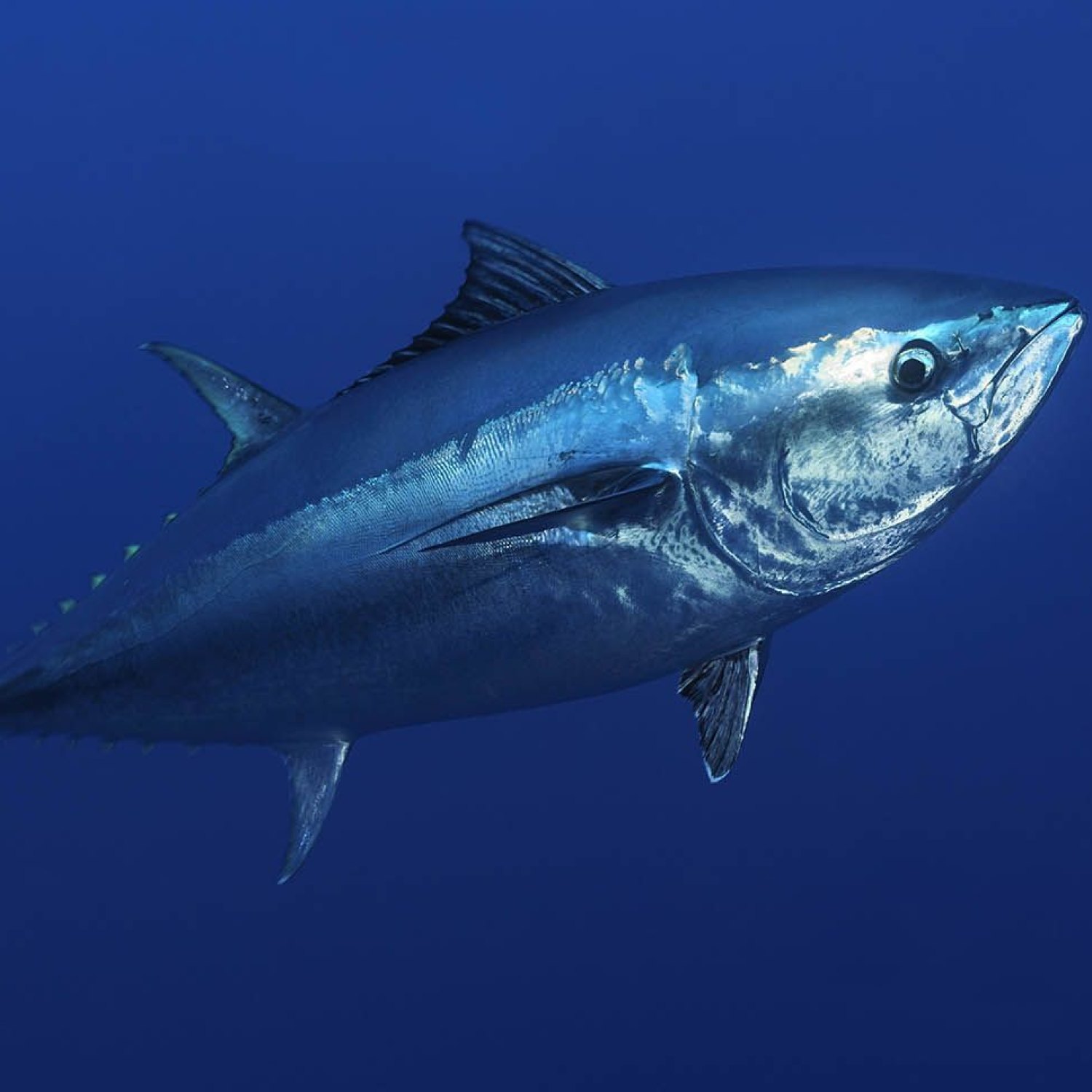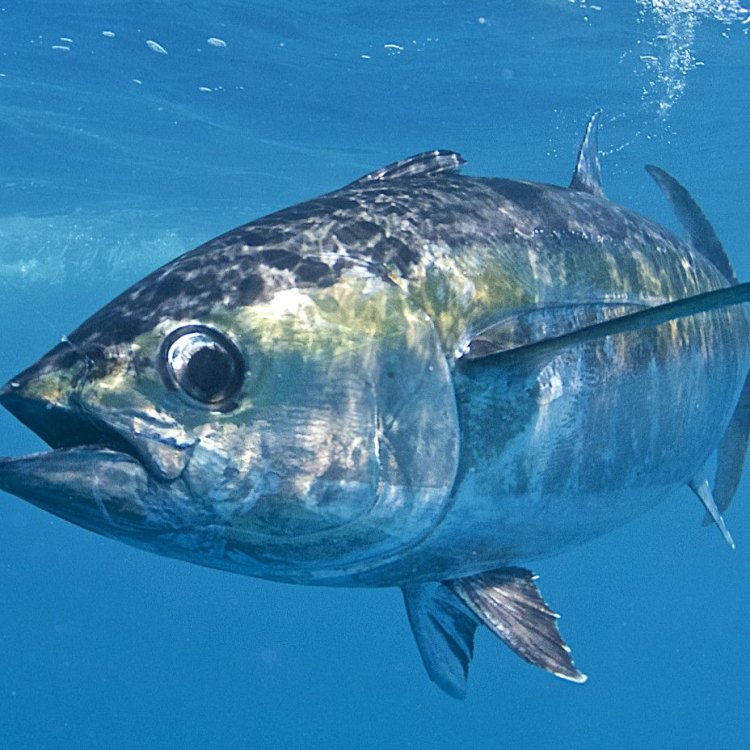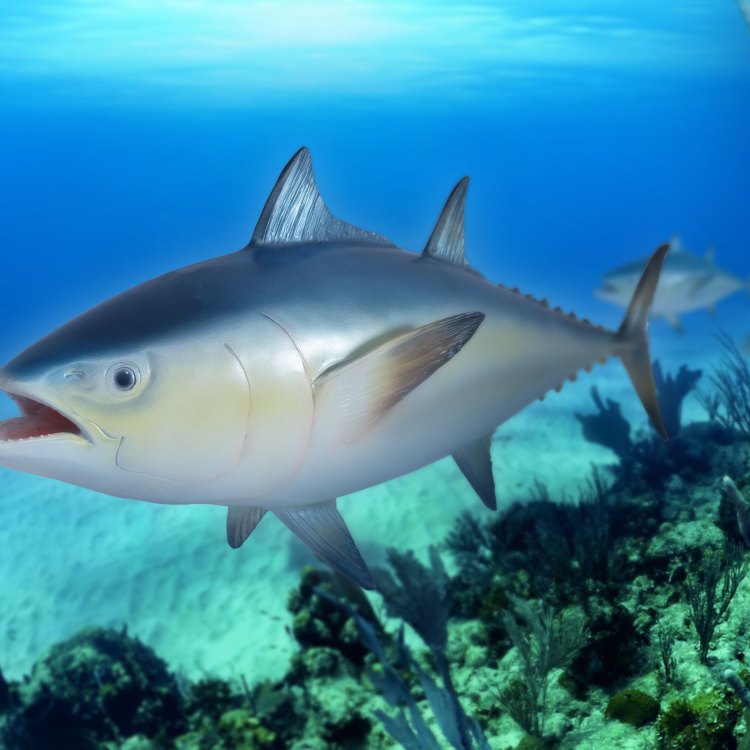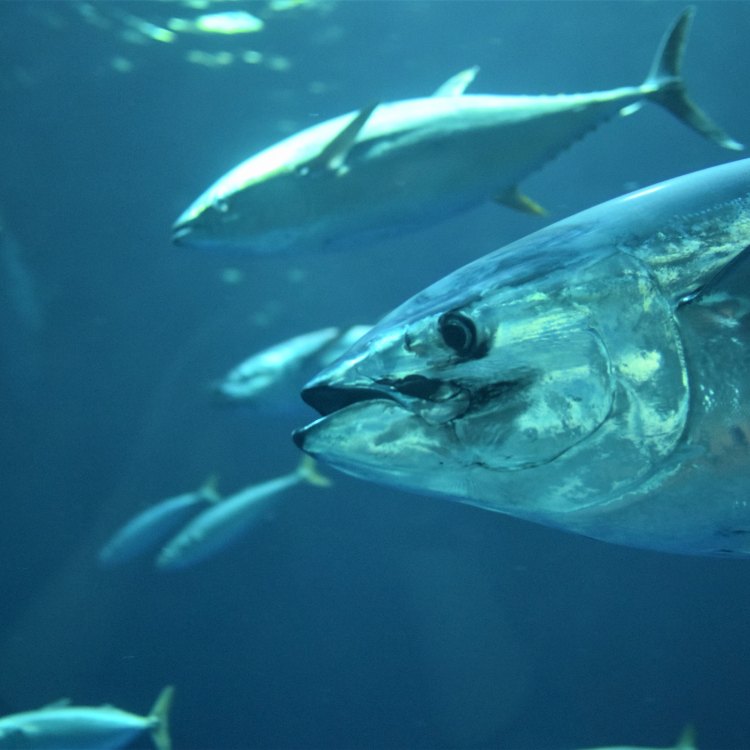
Tuna
Average length varies among species, with some reaching up to 10 feet long
Tuna are large, ocean-dwelling fish that can reach impressive lengths of up to 10 feet. Belonging to the Scombridae family, these streamlined and muscular creatures are found in deep oceanic waters. With various species and an average length that varies, tunas are popular among fishing enthusiasts for their size and strength. Discover more about these magnificent creatures and their importance in our oceans. #tuna #oceanlife #scombridae
Animal Details Summary:
Common Name: Tuna
Kingdom: Animalia
Habitat: Marine
The Mighty Tuna: A Fascinating Creature of the Ocean
The vast and mysterious depths of our oceans are home to a diverse array of magnificent creatures. Among them, one animal that stands out is the Tuna. Sought after by fishermen, loved by seafood lovers, and admired by marine biologists, this remarkable fish is truly a fascinating creature worth learning more about. In this article, we will explore the unique characteristics and traits of the Tuna, from its scientific classification to its feeding habits and geographical distribution Tuna.A Name Fit for Royalty: Thunnus
The Tuna, also known by its scientific name Thunnus, belongs to the kingdom Animalia and phylum Chordata. It is classified under the class Actinopterygii, which includes ray-finned fishes. This class is further divided into the order Perciformes, which comprises nearly 40% of all fish species. Among the Perciformes order, the Tuna belongs to the family Scombridae, which also includes other popular fish like mackerel and bonito.The Ocean's Predator: Habitat and Feeding Habits
As a marine fish, the Tuna inhabits oceanic waters, making it a true creature of the sea. What sets Tuna apart from other fish is its carnivorous feeding method, meaning it primarily feeds on other animals. This formidable predator has a varied diet, consisting of fish, crustaceans, and other small marine creatures.Tunas are known for their exceptional hunting abilities, thanks to their streamlined and muscular body shape. They are built for speed and agility, with a strong and powerful tail fin that propels them through the water at remarkable speeds Tuatara. This makes them efficient hunters, able to overtake their prey with ease.
A Worldwide Wonder: Geographical Distribution and Country of Origin
Tunas are found in oceanic waters all over the world, making them a truly global fish. They are present in all major oceans, from the Atlantic and the Pacific to the Indian and Southern Oceans. Different tuna species can also be found in various regions, including the Mediterranean Sea, the Gulf of Mexico, and the Arabian Sea.Due to their worldwide distribution, it is challenging to pinpoint an exact country of origin for tunas. However, they are famously known to be a staple in Japanese cuisine, and Japan is a significant market for tuna fishing. Other countries known for their tuna fisheries include Spain, the Philippines, and the United States.
The Many Shades of Tuna: Coloration and Body Shape
The Tuna's physical appearance makes it easily distinguishable from other fish species. It has an iconic dark blue color on its back, fading into a silvery color on its sides and belly. This unique coloration helps tunas to blend into their oceanic environment and makes them less visible to potential predators.In terms of body shape, the Tuna's physique is both impressive and practical. Its streamlined body allows it to cut through the water with minimal resistance, enabling it to reach high speeds of up to 50 miles per hour. The Tuna's body is also highly muscular, especially around the tail area, giving it the power to chase and capture its prey successfully.
Size Matters: Length and Diet
Size varies among tuna species, with some smaller varieties reaching a length of only a few inches, while others can grow up to 10 feet long. The average length of most tuna species ranges from 3 to 6 feet, but some larger species can grow up to 13 feet in length. This makes them one of the largest and most impressive fish in the ocean.As mentioned earlier, Tuna's diet primarily consists of other fish, crustaceans, and small marine organisms. This protein-rich diet is essential for their survival, and their constant need for food is what drives them to hunt with such ferocity. Interestingly, tunas also have a unique feeding method known as ram feeding, where they gather in schools and swim through large schools of fish, scooping them up with their open mouths.
Tuna and Humans: A Long History
For centuries, the Tuna's presence has played a significant role in human history and culture. This remarkable fish has been a source of sustenance for many societies, especially those who live near coastal regions. Its nutritional value, combined with its abundance in the ocean, has made it a vital food source for many communities.Aside from its importance as a food source, Tuna has also gained a reputation as a highly prized game fish. Its speed, strength, and fighting capability make it a popular target for anglers, with many thinking of it as the ultimate challenge in sport fishing. The Tuna's value is further elevated by its popularity in international markets, where it is sold for its delicious meat and various other products like canned tuna.
Unfortunately, the popularity and high demand for Tuna have also led to overfishing and the decline of some Tuna species' populations. As a result, conservation efforts and regulations have been put in place to protect these magnificent creatures and ensure their survival for future generations.
The Future of Tuna
As we continue to learn more about Tuna and its importance in our oceans, it is crucial to address the environmental and social impact of its overexploitation. With the rise of sustainable fishing practices and conservation efforts, there is hope for the future of Tuna. Some initiatives, such as the Marine Stewardship Council's certification program, aim to promote sustainable fishing methods and practices to protect marine life, including Tuna.Additionally, advancements in technology, such as improving tracking and monitoring systems, can help regulate the fishing industry and prevent overfishing. By working together and taking responsible actions, we can ensure that Tuna remains an essential part of our oceans for generations to come.
Conclusion
In summary, the Tuna is a truly magnificent creature of the ocean, with a rich history and an essential role in our ecosystem. From its scientific classification as Thunnus to its unique coloration, streamlined body, and impressive size, Tuna continues to captivate us with its beauty and strength. But with this beauty comes a responsibility to protect and conserve this incredible species, ensuring its survival for the benefit of our oceans and future generations. So let us appreciate and admire the mighty Tuna and take action to secure its future.

Tuna
Animal Details Tuna - Scientific Name: Thunnus
- Category: Animals T
- Scientific Name: Thunnus
- Common Name: Tuna
- Kingdom: Animalia
- Phylum: Chordata
- Class: Actinopterygii
- Order: Perciformes
- Family: Scombridae
- Habitat: Marine
- Feeding Method: Carnivorous
- Geographical Distribution: Worldwide
- Country of Origin: Various
- Location: Oceanic waters
- Animal Coloration: Dark blue on the back, yellow on the belly
- Body Shape: Streamlined and muscular
- Length: Average length varies among species, with some reaching up to 10 feet long

Tuna
- Adult Size: Varies among species, with some reaching up to 10 feet long
- Average Lifespan: Varies among species, ranging from 5 to 20 years
- Reproduction: Sexual
- Reproductive Behavior: Spawning
- Sound or Call: Tunas produce sounds using their swim bladder
- Migration Pattern: Tunas are known for long-distance migrations
- Social Groups: Most tunas are solitary, but some species form schools
- Behavior: Fast and powerful swimmers
- Threats: Overfishing is a major threat to tuna populations
- Conservation Status: Varies among species, with some being endangered
- Impact on Ecosystem: Tunas play a crucial role in marine food webs
- Human Use: Tunas are commercially valuable and are consumed as food
- Distinctive Features: Streamlined body, long pectoral fins, and a large mouth
- Interesting Facts: Tunas are known for their incredible swimming speed and endurance
- Predator: Large marine predators such as sharks and killer whales

Thunnus
The Mighty Tuna: A Fascinating and Vital Creature in Our Oceans
In the vast and mysterious depths of our oceans, there is a powerful and elusive creature that has captured the imagination of humans for centuries - the tuna. This fish, with its sleek body, long pectoral fins, and large mouth, is a remarkable and important species that roams the world's oceans.Tunas are incredibly diverse creatures, with over 50 different species, each with its own unique characteristics and behaviors. From the largest species, the Atlantic bluefin tuna, which can reach up to 10 feet in length, to the smaller skipjack tuna, they are all essential and fascinating parts of our ecosystem PeaceOfAnimals.Com.
In this article, we will take a closer look at the remarkable features and behaviors of the tuna, its impact on the ecosystem, and its importance to human use. So, buckle up and join us on a journey to explore the world of the mighty tuna.
Adaptable Species with Different Sizes and Lifespans
The size and lifespan of tuna can vary greatly between species. Some, like the Atlantic bluefin, can grow up to 10 feet long and weigh over 1,000 pounds, while others, like the bullet tuna, only reach about 3 feet in length. However, all tuna species share some common physical characteristics, such as their streamlined bodies and long, powerful pectoral fins that allow them to move swiftly through the water.As for their lifespan, tunas also vary greatly. Some species, such as the Pacific bluefin tuna, can live up to 20 years, while others, like the blackfin tuna, have a lifespan of only 5 years. But despite their differences, all tunas are known for their incredible swimming speed and endurance, making them some of the most powerful swimmers in the ocean.
Reproduction and Spawning Behavior
Like most fish, tunas reproduce sexually Treeing Tennessee Brindle. They have separate male and female individuals, and fertilization occurs externally. During spawning season, which varies among species, male tunas will release sperm into the water, and the females will release their eggs. This spawning behavior often takes place in large groups, increasing the chances of successful fertilization.After hatching, tuna larvae will spend their early stages in the open ocean, feeding on zooplankton and other small organisms. As they mature, they will gradually move closer to the shore, where they will join the adult tuna population and continue their life cycle.
Tuna Sounds: The Music of the Ocean
One of the most fascinating features of tunas is their ability to produce sounds. They do this by using their swim bladder, a gas-filled organ that helps them regulate their buoyancy and depth in the water. By vibrating this organ, tunas can produce a variety of sounds, which scientists believe are used for communication and navigation.Tuna calls can range from grunts and growls to whistles and moans, and can even be heard by humans above the water's surface. These sounds not only serve as a way for tunas to communicate with each other, but they also play a crucial role in their survival.
The Mysterious Migration Pattern of Tunas
Tunas are known for their impressive long-distance migrations. From the warm waters of the tropics to the colder waters of the poles, tunas travel thousands of miles every year, in search of food and suitable spawning grounds.Scientists believe that tuna migrations are triggered by changes in water temperature and food availability. They also use ocean currents to help them conserve energy during their journey.
Tunas are not only skilled at navigating these long distances, but they are also able to maintain their body temperature to adapt to different water temperatures, making them true ocean travelers.
Solitary Swimmers or Social Creatures?
While most tunas are solitary creatures, some species do form large schools. This is especially true during spawning season, when tunas gather in large numbers to increase their chances of successful reproduction. These schools can consist of thousands of individual tunas, making it an incredible sight to witness.So, why do some tunas form schools while others prefer to be alone? Scientists believe that tunas form schools for protection and to help them locate food more efficiently. In these schools, they are also able to communicate with each other through vocalizations, further enhancing their survival.
Threats and Conservation Status: A Battle Against Overfishing
Sadly, one of the biggest threats to tuna populations is overfishing. Due to their commercial value and high demand for their meat, tunas are heavily targeted by the fishing industry. In some cases, entire populations have been severely depleted, leading to some species being listed as endangered.To address this issue, some countries have implemented fishing quotas and regulations to protect tuna populations. This has been a positive step towards conserving these remarkable creatures, but more efforts are needed to ensure their survival.
The Vital Role of Tunas in Our Ecosystem
Tunas play a crucial role in marine food webs, making them essential for maintaining a healthy ecosystem. As predators, they help control the population of their prey species, and their migration patterns also help to distribute nutrients throughout the oceans. They are also a food source for many marine animals, including large predators such as sharks and killer whales.Without tunas, the delicate balance of our oceans could be disrupted, leading to negative effects on other species and the entire ecosystem.
The Human Use of Tunas: A Commercially Valuable Fish
Aside from being an important part of the ecosystem, tunas are also commercially valuable and widely consumed as food. Their meat is prized for its taste and high nutritional value, making them a popular choice for sushi and sashimi dishes.Tunas are also used in the production of fish oil and fishmeal, which are essential components in various industries, such as cosmetics and animal feed.
Fascinating Facts About Tunas
Tunas are full of surprises, and here are some interesting facts that you may not know about these amazing creatures:- Tunas are warm-blooded fish, meaning they are able to regulate their own body temperature.
- The bluefin tuna can swim at speeds of up to 43 miles per hour, making it one of the fastest fish in the ocean.
- Tunas have excellent vision, allowing them to spot their prey from great distances.
- They are known for their endurance, and some species can swim continuously for days, covering thousands of miles.
- Tunas are not only found in the open ocean, but they can also be found in shallow waters, such as estuaries and bays.
In Conclusion
Tunas are incredible and vital creatures in our oceans. From their impressive size and speed to their unique sounds and remarkable migrations, they continue to captivate and amaze us.However, as with many marine species, tunas face numerous threats, and their populations must be managed carefully to ensure their survival. It is crucial that we take action now to protect and conserve these remarkable creatures for future generations to appreciate and enjoy. Let us all come together to protect the mighty tuna, a true symbol of the power and beauty of our oceans.

The Mighty Tuna: A Fascinating Creature of the Ocean
Disclaimer: The content provided is for informational purposes only. We cannot guarantee the accuracy of the information on this page 100%. All information provided here may change without prior notice.












